中考英语语法复习-冠词 教学 课件
中考英语语法---冠词

中考英语语法---冠词冠词用法口诀定冠词用法有规律,防止遗忘很容易。
特指双方都熟悉,上文已经被提及。
世上无二仅独一,序数词和最高级。
山河海岛建筑物,姓氏复数奏乐器。
少数形表人一类,方位名词须牢记。
普构专有惯用词,试用此诀有效率。
下列情况不用冠,名词之前代词限。
专有名词不可数,球类学科与三餐。
复数名词表泛指,节日月份星期前。
颜色语种和国名,称呼习语及头衔。
1.不定冠词a/ana用在辅音音素开头的词前eg. a booka useful book a “u” a university a one-year boy[ju:sful] [ju:] [ju:] [wʌn]an用于元音开头的词前. eg. an applean hour an “F”an honest boy[au ] [ef] [on](1)固定搭配a lot of, a little,a few, have a look,have a try,have a swim,a quarter(一刻钟),half an hour, three times a day,have a talk,give a talk,ten Yuan a kilo(千克)(2)注意不定冠词的特殊位置当名词被such,what,many修饰时,不定冠词放在这些词之后。
What a dangerous job it is!Many a man has gone to the big cities for work.当名词前的形容词前有so,how,too等词时,不定冠词应放在形容词之后。
She was so nice a girl that she took the blind man to the station.How nice a film this is!当名词前面有形容词和quite,rather,very(三个都是非常的意思)时,不定冠词放在quite,rather 之后,very之前。
2018中考仁爱英语语法复习:冠词课件 (共16张PPT)

知识讲解
冠词
不定冠词的用法
不定冠词有两个,a 和 an。
a用在辅音开头的单词前面,an用于以元音开头的单词前。
a book an apple 1. 不定冠词用在单数可数名词前表示“某一个”。 There is a policeman at the door.
知识讲解
冠词
不定冠词的用法
2. 不定冠词用在单数可数名词之前,表示“任何,每个”。
He wants to buy a Kodak.
7. 不定冠词用于某些固定短语中。 have a try试一下 take a break 休息一下 have a good time 玩得痛快 in a word 总而言之 make a living 谋生 as a matter of fact 事实上
She is a teacher.
We all thought him a suitable person for the job. 5. 不定冠词用在价格、速度、比率等短语中。 six kilometers an hour 3 times a day
知识讲解
冠词
不定冠词的用法
6. 不定冠词用在专有名词前。
知识讲解
冠词
定冠词的用法
1. 定冠词和名词连用,表示某个或某些特定的人或东西。
Mother cut the meat into slices.
2. 定冠词用于可数名词前,表示一类人或东西。 The horse is a useful animal.
知识讲解
冠词
定冠词的用法
3. 定冠词用于第二次出现的名词之前。 I got a letter yesterday. The letter was sent by e-mail. 4. 定冠词用于有词组或者定语从句修饰的名词前。
初中英语冠词 不定冠词与定冠词 课件PPT

巧学妙计
定冠词the的基本用法 特指双熟悉,上文已提及, 世上独一无二,序数最高级。 形容词前一类人,特殊用法特殊记。
Finish the following tasks.
1. Circle a/an/the.
—What’s this? —It’s cup. —What color is the cup? —It’s red.
✓ 用在方位名词前。
the east 东方 the west 西方
✓ 与play连用时,用在乐器名词前。 play the piano 弹钢琴 play the guitar 弹吉他
✓ 与专有名词连用。 ✓ 用在一些固定短语中。
the Great Wall 长城 the Summer Palace 颐和园 in the morning/afternoon/evening 在上午/下午/晚上
•冠词的分类与用法
分类 冠词
用法
不定冠词:a an
定冠词:the
零冠词:/ 不定冠词
定冠词
a用在以辅音音素开头的名词之前
an用在以元音音素开头的名词之前
A E I U O 是五个元音字母。
活学巧用
用a/an填空
1.I have ___ apple. He has ___ orange. 2.We should take exercise for ___ hour every day. 3.There is ___ “u” and ___“s” in the word “use”.
我有一只漂亮的猫。这只猫是白色的。
词汇小知识——a和an的区别
在英语中,a和an都有“一”的意思,是不定冠词,泛指一类事 物或事物中的任何一个,主要用于修饰可数名词单数,但它们的用法 不一样,用a还是用an要根据后面单词的音标,音标中的第一个音素 如果是元音音素就用an,如果是辅音音素就用a。 例如:
初中英语语法复习-冠词PPT课件

a, an的位置
1. 一般放所修饰的名词前 a little boy, a computer
2. 放在half,many,such,what之后 half an hour such a good boy=so good a boy what a beautiful …
3)定冠词the用于序数词前或表示方位的名词前 和形容词最高级前
*the first *the best *in the south
4)乐器名称前用定冠词the
* play the piano * play the violin
5)在复数姓氏前加the,表示××一家人,
常看成复数
*The Browns are going to Shanghai for a
* They met here this morning.
* Each boy has a workbook.
4)一些专有名词、不可数名词、称呼、头衔 不用冠词
China Grade Two
Mr. Li Dr. Liu meat
5)表示颜色、语言、国家前不用冠词
* in purple * in red
2 Did you play ____/ ____ basketball or play __t_h_e____ piano after ___/____school? 3 Turn right at ___t_h_e___ third crossing on ___th__e___ left.
4 They got to ___th__e___ moon by ____/____ spaceship. 5 She is ___a_____ university student, she likes __th_e_____ music of __t_h_e____ film.
中考英语语法复习名词代词数词冠词和介词
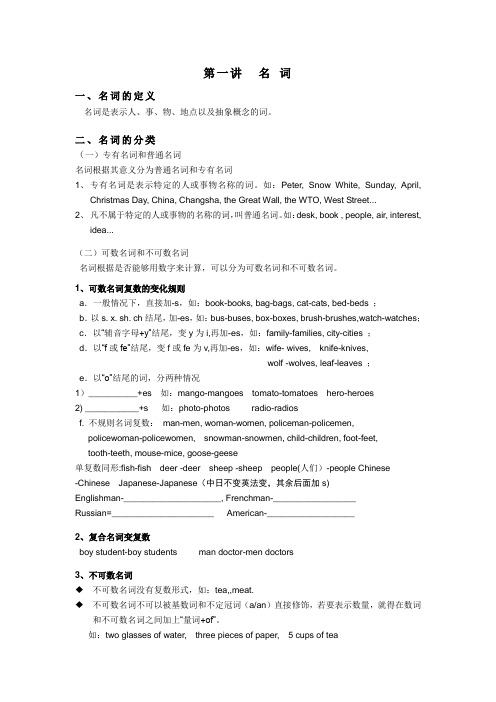
第一讲名词一、名词的定义名词是表示人、事、物、地点以及抽象概念的词。
二、名词的分类(一)专有名词和普通名词名词根据其意义分为普通名词和专有名词1、专有名词是表示特定的人或事物名称的词。
如:Peter, Snow White, Sunday, April,Christmas Day, China, Changsha, the Great Wall, the WTO, West Street...2、凡不属于特定的人或事物的名称的词,叫普通名词。
如:desk, book , people, air, interest,idea...(二)可数名词和不可数名词名词根据是否能够用数字来计算,可以分为可数名词和不可数名词。
1、可数名词复数的变化规则a.一般情况下,直接加-s,如:book-books, bag-bags, cat-cats, bed-beds ;b.以s. x. sh. ch结尾,加-es,如:bus-buses, box-boxes, brush-brushes,watch-watches;c.以“辅音字母+y”结尾,变y为i,再加-es,如:family-families, city-cities ;d.以“f或fe”结尾,变f或fe为v,再加-es,如:wife- wives, knife-knives,wolf -wolves, leaf-leaves ;e.以“o”结尾的词,分两种情况1)__________+es 如:mango-mangoes tomato-tomatoes hero-heroes2) ___________+s 如:photo-photos radio-radiosf. 不规则名词复数:man-men, woman-women, policeman-policemen,policewoman-policewomen, snowman-snowmen, child-children, foot-feet,tooth-teeth, mouse-mice, goose-geese单复数同形:fish-fish deer -deer sheep -sheep people(人们)-people Chinese-Chinese Japanese-Japanese(中日不变英法变,其余后面加s)Englishman-____________________, Frenchman-_________________Russian=_____________________ American-__________________2、复合名词变复数boy student-boy students man doctor-men doctors3、不可数名词◆不可数名词没有复数形式,如:tea,,meat.◆不可数名词不可以被基数词和不定冠词(a/an)直接修饰,若要表示数量,就得在数词和不可数名词之间加上“量词+of”。
2023年中考英语语法复习课件5+冠词
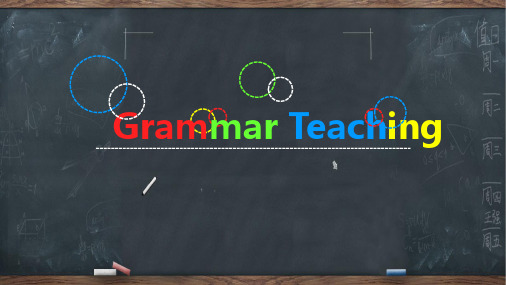
与乐器或娱乐场所连用,表示全体
E.g. play the piano
go to the theatre
2023/3/25
定冠词the的用法 特指
He has got a headache.
习语 E.g. a couple of
a great deal of a great many a lot of have a good time in a hurry keep an eye on lend a hand
2023/3/25
定冠词the的用法
in honor of
in order to
They had little confidence in the doctors.
2023/3/25
定冠词the的用法
类指
与形容词或分词(-ing/-ed)连用,表示一类人或事物,动词一般用复数 E.g. The rich are getting richer and the poor are getting poorer.
2023/3/25
零位冠词的用法
用于类指的复数名词 E.g. I like horses.
She likes flowers.
用于类指的抽象名词或不可数名词 E.g. Men fear death.
Paper is made of wood.
2023/3/25
零位冠词的用法
表示头衔、职务
E.g. He is elected monitor of the class. He is chairman of the English Department. He is elected president. They appointed her manager.
英语语法L1-冠词a, an, the 课件

a /an
(3) a用在以辅音音素开头的单词前;an用在以元音音素开头的单词前。
a banana
an apple
a CD
__a__ boiled egg __a_n_ English lesson __a__ uniform
an ID card
__a_n_ hour
【易错警示】
有些单词虽然是以元音字母开头,但是却发辅音音,用a; 有些单词虽然以辅音字母开头,但是却发元音,用an。
a: useful,usual, university, unit, European, one-way an: hour, honest, honor
umbrella, ugly, uncle, unusual
the
(1)当我们第一次提到某个人或可数的事物时,我们通常使用不定冠词 ____a___ 或 ___a_n___。 当我们再次提到这个名词时,我们使用定冠词 __t_h_e___。
2. ___a_____ window 3. ___a_____ horse
4. ____a_n___ airport 5. ____a____ new airport 6. ____a____ university
7. ____a____ useful book
8. math teacher
__t_h_e___ ___r_i_ch__富人 ___th_e___ ___b_li_n_d_盲人
WeChat is very popular. Not only the young but also the old are getting interested in it.
11
(8) the用于海洋、江湖、山脉、群岛、海峡、海湾等地理专有名词前。
初中英语语法——冠词(共26张PPT)

2.__A__girl in white is a nurse.
A.The B.A C.An D./
3.We can’t see__C__sun at ____night.
A.a, / B.a, the C.the, / D.the, the
4.Jack is learning__C__Chinese and he says____
D.the, / the
10. I want to try again. Please give me__A__ third chance.
A.a B.the C.an D./
11Swimming is ___B____ in summer.
A.a great fun
B.great fun
C.great a fun D.great funs
--- It’s___a_n___animal. 5. We can’t live without_不__用__填__air.
1.He is _D___cleverest student in our class and always
gets____first.
A./, the B./, / C.a, / D.the, the
笔
记
• a lot of, a moment ago, a few, a little
小试猪刀
• an apple •an airport •an important bag •an honest man •an hour • a university • a one-eyed girl
定冠词the的用法
指 用以特指某(些)人或某(些)事物
• This is the house where Luxun once lived. 这是鲁迅曾经住过的房子。
初中英语语法—冠词课件(26张)

2021/8/12
The cake is delicious,and I would like a_second one. 蛋糕很好吃,我想再吃一块。 3.a number of与the number of的辨析 A number of students like playing computer games. 许多学生喜欢玩电脑游戏。 The number of the students is about 1,500 in our school. 我们学校学生的人数大约是1500。 a number of 意思是“许多”,相当于a lot of;the number of意思是 “……的数目,……的数量”,当它作主语时,谓语动词用单数形式。如:
2021/8/12
7.泛指的复数名词前不用冠词。 Animals live in the forest. 动物生活在树林里。 8.与by连用的交通工具前不用冠词,但与take或介词连用时,名词 前要加冠词。 They often go to school by bus. 他们通常坐公共汽车去上学。 take a bus,in a boat,on the bike 9.在某些固定的词组或习语中,不用冠词。 face to face,watch TV,step by step,at first/last, in trouble/danger, on/in time,go to school/work,at noon/night
2021/8/12
11.用在惯用语中。 in the morning/afternoon/evening,in the end,by the way,at the age of,at the moment等。 12.用于方向名词或表示江河、山脉、海峡等专有地理名称前。 in the southeast of,at the back of,the Red Sea 13.用在逢十的复数名词前,表示年代,也指人的大约岁数。 The young girl is in the twenties. 这个年轻的女孩大约二十几岁。 The war broke out in the forties. 这场战争发生在40年代。
英语语法冠词复习公开课课件

巧学妙记
特指双熟悉,上文已提 及,世上独无二, 序数最高级,某些专有 名,习语和乐器。
PART 03
零冠词
零冠词
某些名词前不需要用冠词,这种情况称为零冠词。
(1)一些由普通名词构成的专有名词前不用冠词,如街名、 广场名、公园名、大学名、节日名等
Nanjing Road南京路
Times Square时代广场
冠词复习课件
1 不定冠词 3 零冠词
目录
2 定冠词 4 巩固练习
什么是冠词
冠词位于名词之前,是用来帮助说明名词所指的人或事物 的一种虚词。它不能离开名词而单独使用。冠词分为不定冠词 (a和an)和定冠词(the)两种。在一些特定情况下,名词前 不用冠词我们称之为“零冠词”。
PART 01
不定冠词
A. a
Hale Waihona Puke B. theC. /
【解析】选C。考查零冠词的用法。on foot“步行”为固定短语, 不需要用冠词。
谢谢观赏
Thank You For Watching
(3)用在重量、长度、时间等单 位名词前,表示“每一”
Take the medicine three times a day. 这种药每天吃三次。
(4)用于某些固定短语
have a look看一看
巧学妙记
不定冠词a或an,基本用 法记心间; 辅音音素前用a,元音音 素前用an; 人或事物首次提,泛指 某人或某物; 单位价格表每一,习惯 用法心中记。
不定冠词的常见特殊用法
用法
例句
(1) 用 在 不 可 数 名 词 前 表 示 May I have a coffee? “一种、一份、一杯”等 我可以喝杯咖啡吗?
中考英语总复习+语法专题课件 冠词
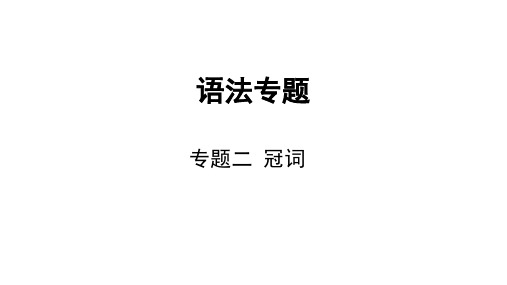
表示数量“一”,相当于one:I have a basketball. 我有一个篮球。
第一次提到某物或人:An old lady is waiting for you. 一位年长的女士在等你。
表示“每一”,相当于every:once a week
小语篇训练——用适当的冠词填空,不需要的画“/”。 The graduation ceremony is over. 1. . number of students attended the ceremony.We will leave school soon.I feel very excited because I am one of 2. . best graduates(毕业生).At 3. . same time, I am a little sad because I have to say goodbye to my classmates and teachers.I want to take photos with them.In 4. . past three years, I had 5. . good time in No.1Middle School.Our teachers taught us a lot in 6. . class.In 7. . future, I hope I could be 8. . better student.
B
A. A; an B. The; a C. An; the D. The; an
4. Bob is my brother.He likes playing ________ basketball, but he doesn't like playing ________ piano.(2023·绥化)( )
中考英语语法讲解课件-名词冠词数词29页PPT

谢谢你的阅读
❖ 知识就是财富 ❖ 丰富你的人生
71、既然我已经踏上这条道路,那么,任何东西都不应妨碍我沿着这条路走下去。——康德 72、家庭成为快乐的种子在外也不致成为障碍物但在旅行之际却是夜间的伴侣。——西塞罗 73、坚持意志伟大的事业需要始终不渝的精神。——伏尔泰 74、路漫漫其修道远,吾将上下而求索。——屈原 75、内外相应,言词
21、没有人陪你走一辈子,所以你要 适应孤 独,没 有人会 帮你一 辈子, 所以你 要奋斗 一生。 22、当眼泪流尽的时候,留下的应该 是坚强 。 23、要改变命运,首先改变自己。
24、勇气很有理由被当作人类德性之 首,因 为这种 德性保 证了所 有其余 的德性 。--温 斯顿. 丘吉尔 。 25、梯子的梯阶从来不是用来搁脚的 ,它只 是让人 们的脚 放上一 段时间 ,以便 让别一 只脚能 够再往 上登。
初中英语语法讲义--冠词
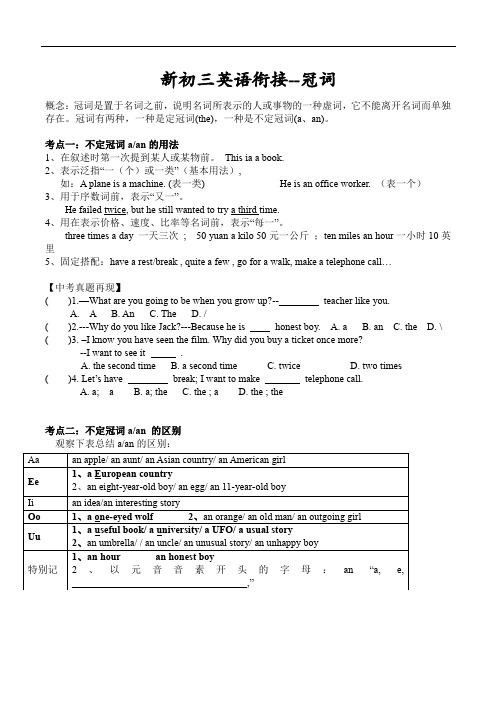
新初三英语衔接--冠词概念:冠词是置于名词之前,说明名词所表示的人或事物的一种虚词,它不能离开名词而单独存在。
冠词有两种,一种是定冠词(the),一种是不定冠词(a、an)。
考点一:不定冠词a/an的用法1、在叙述时第一次提到某人或某物前。
This ia a book.2、表示泛指“一(个)或一类”(基本用法),如:A plane is a machine. (表一类) He is an office worker. (表一个)3、用于序数词前,表示“又一”。
He failed twice, but he still wanted to try a third time.4、用在表示价格、速度、比率等名词前,表示“每一”。
three times a day 一天三次; 50 yuan a kilo 50元一公斤;ten miles an hour一小时10英里5、固定搭配:have a rest/break , quite a few , go for a walk, make a telephone call…【中考真题再现】( )1.—What are you going to be when you grow up?--teacher like you.A. AB. AnC. TheD. /( )2.---Why do you like Jack?---Because he is honest boy. A. a B. an C. the D. \ ( )3. –I know you have seen the film. Why did you buy a ticket once more?--I want to see it .A. the second timeB. a second timeC. twiceD. two times( )4. Let’s have break; I want to make telephone call.A. a; aB. a; theC. the ; aD. the ; the考点二:不定冠词a/an 的区别观察下表总结a/an的区别:【中考真题再现】( )1.---What do you want to be in the future, Nick?--- I want to be pilot. It is exciting job.A. a; aB. a; anC. the, anD. a; the( )2. As we know, England is European country and Singapore is -------Asian country.A. an; anB. an; aC. a; aD. a; an考点三:定冠词the的用法1、特指的人或事之前。
中考英语语法讲解课件-名词冠词数词

·人教版
y i (3) 以 辅 音 字 母 + y 结 尾 的 名 词 , 变 ______ 为 ______ , 再 加 es 。 ______。 如 : factory→factories; library→libraries; city→cities ; ; ; country→countries ; story→stories ; family→families ; strawberry→strawberries; ; dictionary→dictionaries;party→parties;hobby→hobbies。 ; ; 。 (4) 以 o 结 尾 的 大 多 加 s , 少 数 加 es 。 如 : zoo→zoos ; photo→photos;radio→radios;piano→pianos; ; ; ; kangaroo→kangaroos ; hero→heroes ; tomato→tomatoes ; potato→potatoes。 。 f 或 fe 为 v 加 es 。 (5)以f或fe结尾的词, 变 ______或______为______加______。 结尾的词, 以 或 结尾的词 如 : knife→knives; leaf→leaves; shelf→shelves; half→halves; ; ; ; ; thief→thieves;wife→wives;wolf→wolves;life→lives。 ; ; ; 。
·人教版
4.不可数名词量的表达 . 不可数名词的数量,要借助一个可数名词来表达,其结构为: 不可数名词的数量,要借助一个可数名词来表达,其结构为: 数词+可数名词+ +不可数名词。 数词+可数名词+of+不可数名词。如: a piece of bread 一块面包 __________________ two cups of tea 两杯茶 __________________ three glasses of orange 三杯橘汁 __________________
中考英语语法突破【专题3】冠词知识点复习总结ppt课件(28页)
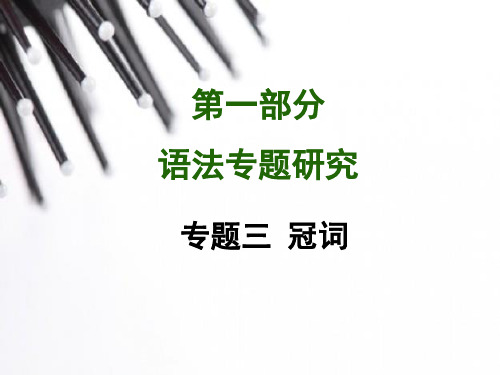
—Yes, it was really good. I think ____
boy in white was the best actor. A. a B. an C. the D. /
【解析】考查定冠词的用法。句意为“我非常 喜欢那场表演。”“是的,它真的不错。我认 为那个穿白衣服的男孩是最优秀的演员。”a表 泛指,用在辅音音素开头的单词前;an表泛指, 用在元音音素开头的单词前;the表特指;零冠 词放在诸如球类、三餐等名词前。此语境中表
中是 _____ 个诚实的人。 a表泛指,用在辅音音素开
头的单词前; an表泛指,用在元音音素开头的单词 球类等名词前。此处表泛指,又因 honest 为元音音 素开头的单词,其前冠词应用an。故选B。
前;the表特指;零冠词有特殊的用法,如用于三餐、
3. —I enjoyed the performance very much.
特指,故选C。
4. Mary was born in 1998 and she began to play _____ guitar at the age of seven. A. a B. 不 填 C. the D. an
【解析】 考查定冠词的用法。句意为:玛丽出生于 1998年,她七岁时开始弹吉他。a表泛指,用在辅音 音素开头的单词前; an 表泛指,用在元音音素开头
中
(2)通常不定冠词a用在以辅音音素开
头的单数可数名词前;an用在以元音音素开头
的单数可数名词前。判断一个单词是以元音 音素开头还是以辅音音素开头,要根据其读 音,而不是根据其字母。中考中常见的以元 音字母开头的单词有:
Aa
an apple/an artist/an aunt/an
【中考英语复习之语法过关(牛津译林版)】课时01 名词 冠词(教师版)

第一课时名词、冠词1.名词名词是历年中考的重要考点,常常出现在完形填空、语法填空题型中。
名词部分主要考查: ①名词的数(可数与不可数、单数与复数) ①名词和冠词的搭配①抽象名词的具体化 ①名词的词性变化①名词的词义辨析1.(1)规则变化①以-o 结尾的下列名词要加-es :“黑人英雄爱吃土豆、西红柿”,即Negroes ,heroes, potatoes ,tomatoes 。
①以-f 或-fe 结尾的名词需要把f 或fe 去掉,加-ves :“为了自己活命,小偷和他的妻子手里拿着刀子和树叶站在架子上,把狼劈成两半”,即selves ,lives ,thieves ,wives ,knives ,leaves ,shelves ,wolves ,halves 。
(2)不规则变化但是没有起作用的。
1.-’s ’s 或’;表示共同的所有关系时,只在最后一个名词后加-’s 或’。
①表示店铺、办公室或某人的家时,名词所有格后被修饰的名词一般省略。
Tom’s and Jim’s rooms 汤姆和吉姆(各自)的房间Tom and Jim’s room 汤姆和吉姆(共同)的房间at the barber’s 在理发店2.of 所有格:无生命的事物的名词通常用of 所有格表示所有关系;名词短语或有定语修饰的有生命的名词也常用of 所有格。
the content of the novel 小说的内容the name of the girl over there 那边那位女孩的名字3.双重所有格:“名词+of +名词所有格”或“名词+of +名词性物主代词”。
a play of Shakespeare’s 莎士比亚的一个戏剧a photo of mine我的一张照片随堂练习考点1名词辨析①.单项选择1.—We can always find something good in a bad if we look for it.—It’s so true. Let’s make full use of what comes.A.situationB.directionC.instructionpetition【答案】A本题考查名词词义辨析。
- 1、下载文档前请自行甄别文档内容的完整性,平台不提供额外的编辑、内容补充、找答案等附加服务。
- 2、"仅部分预览"的文档,不可在线预览部分如存在完整性等问题,可反馈申请退款(可完整预览的文档不适用该条件!)。
- 3、如文档侵犯您的权益,请联系客服反馈,我们会尽快为您处理(人工客服工作时间:9:00-18:30)。
3)表示某个人或事物,但不具体说明何人或何物。 如:A boy was waiting for you.
4)表示人或事物的某一类。 如:Pass me an apple, please.
5)表示“每一”的意思,相当于every。 如: Mr. Green goes to the cinema once a week.
13)用在某些习惯用语中。 如:in the morning, by the way, look the same, etc.
14)用来表示某个世纪中的几十年代 如: in the 1970s; in the 1970’s 在20世纪70年代
15) The +比较级+…, the +比较级+…,越…..就越……
Man cannot live without water.
7)节日、星期、月份、季节名称前。 如:June 1 is Children’s Day. 8)表示颜色、语言、称呼语和官职、头衔的名词前。 如:Headmaster Li came to Class One just now. 9)某些固定词组或习惯用语中。 如:at night, go to school, by bus, etc.
7)用在某些建筑物名词前。 如:the White House, the Great Hall of the People
8)用在姓氏复数形式之前,表示“某某一家”或 “某某夫妇”。 如:the Greens, the Blacks, etc.
9)用在西洋乐器名词前。 如:the piano, the violin, etc.
5)in front of在…的前面 ; in the front of在…的前部.
*26个字母前面用 an 的有:
Mr Li has one fox.
*前面应该加 a 的易错词:
一个(one)普通(usual)却有 用(useful)的欧洲(european) 大学(university)联盟(union)。
10)用在少数名词化的形容词前表示一类人或事物。 如:the old, the poor, the blind, etc. 11)用在表示方向位置的名词前。 如:in the east, on the right, in the centre, etc.
12)用在由普通名词构成的专有名词前。 如:the People’s Republic of China, etc.
参赛可修改优质的课件
主讲人:***
冠词是虚词,本身不能单独使用,也没有词义,
它用在名词的前面,帮助指明名词的含义。
分类
定冠词 the 不定冠词 a an 零冠词 /
A 和An
1)表示数量有“一”的意思,但数的概念没有one强。 如:I have a mouth, a nose and two eyes. 2)第一次提到某人或某物,不定冠词起介绍作用。 如:Yesterday I saw an old man. He’s Tom’s father.
1. _____Greens are preparing for the coming Thanksgiving Day.
A./
B. A
C. An
D. The
2. Her daughter began to play____ piano when she was five. Now she's good at it.
5)用在序数词和形容词最高级前。 如:The third one is carrying the fewest of all.
6)用在山脉、江河、海洋、岛等名词前。 如:the Himalaya Mountains, the Yellow River, the Red
Sea, the Taiwan Island, etc.
3)球类活动、学科名词、一日三餐前。 如:We have English and math every day. 4)复数名词表示泛指。 如:They are workers.
5)抽象名词表示一般概念时,通常不加冠词 Failure is the mother of success.
6)物质名词表示一般概念时,通常不加冠词。当表 示特定的意思时,需要加定冠词
18) 用在中国传统节日前 the Spring Festival 中秋节、端午节
零冠词(不用冠词)
1)名词前已有作定语的指示代词、物主代词或不定代词 等限定词。
如:The letter is in her bag. I have some questions.
2)专有名词、物质名词和抽象名词等不可数名词前。 如:China,water,music, etc.
16) 用在单数时间名词、计量单位前,构成 by the + n. 表示“按…计算” He is paid by the hour / by the day. Apples are sold by the kilo.
17) 用在表示身体部位的名词前: She caught me by the arm.
*定冠不定冠)at table在吃饭;
at the table在桌子旁
2)in class在上课;
in the class在班级中
3)go to school去上学; go to the school到那所学校去
4)go to bed上床睡觉; go to the bed到床那边去
6)用于序数词前,表示”又一” 如: The cake is delicious,and I want a second one.
The
l)特指某人或某物。 如:The book on the desk is mine. 2)指双方都知道的人或事物。 如:Where are the new books,Jim? 3)指上文提到过的人或物。 如:There is an old woman standing there. The old woman looked worried. 4)用在世上独一无二的事物名词前。 如:the sun, the sky, the earth, the world, …..
